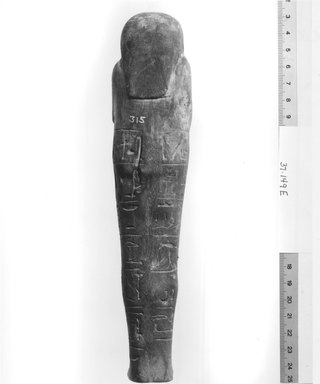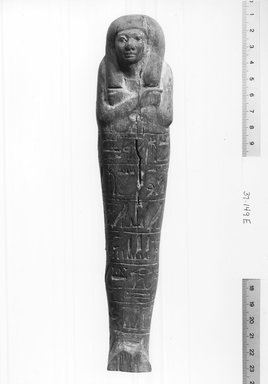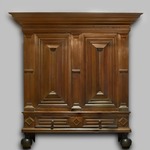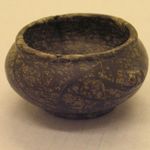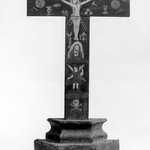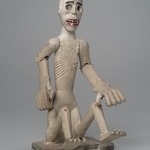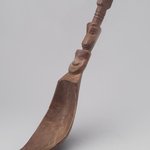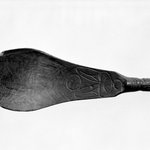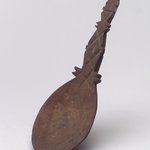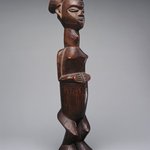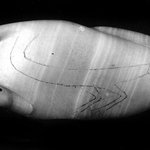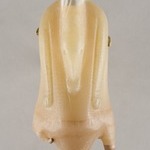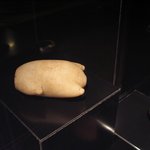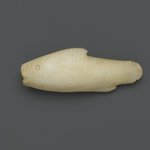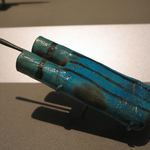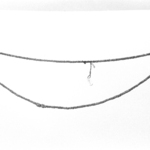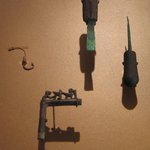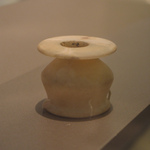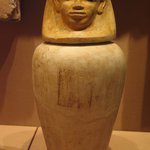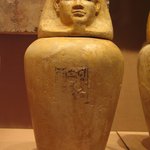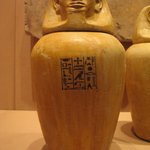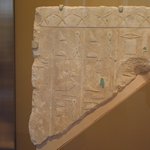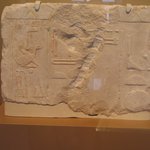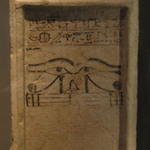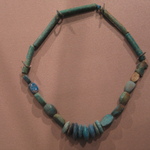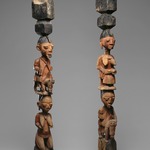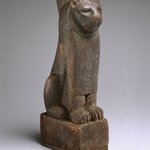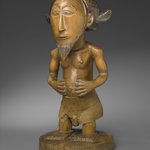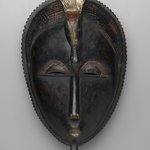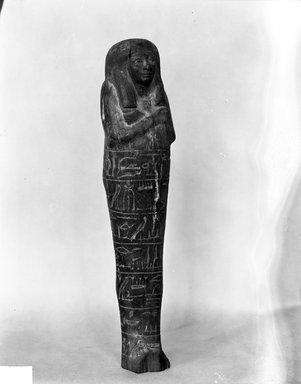

Shabty of Amunmose, ca. 1479–1352 B.C.E. Wood, 8 9/16 x 2 1/16 in. (21.7 x 5.3 cm). Brooklyn Museum, Charles Edwin Wilbour Fund, 37.149E. Creative Commons-BY (Photo: Brooklyn Museum, 37.149E_NegC_glass_bw_SL4.jpg)

Shabty of Amunmose, ca. 1479–1352 B.C.E. Wood, 8 9/16 x 2 1/16 in. (21.7 x 5.3 cm). Brooklyn Museum, Charles Edwin Wilbour Fund, 37.149E. Creative Commons-BY (Photo: Brooklyn Museum, CUR.37.149E_erg456.jpg)
Shabty of Amunmose
Egyptian, Classical, Ancient Near Eastern Art
On View: Egyptian Orientation Gallery, 3rd Floor
New Kingdom Funerary Arts
Far from being static, as people often think, Egyptian art developed and evolved over time.
Although funerary objects such as coffins, canopic jars, shabties, and model food offerings were already known in the Middle Kingdom, many of their forms had changed significantly by the time of the New Kingdom. Some differences may reflect the desire to conform to contemporary aesthetic standards. Other new designs suggest a conscious attempt to enhance an object’s magical potency, thus increasing the deceased’s potential for life after death.
Far from being static, as people often think, Egyptian art developed and evolved over time.
Although funerary objects such as coffins, canopic jars, shabties, and model food offerings were already known in the Middle Kingdom, many of their forms had changed significantly by the time of the New Kingdom. Some differences may reflect the desire to conform to contemporary aesthetic standards. Other new designs suggest a conscious attempt to enhance an object’s magical potency, thus increasing the deceased’s potential for life after death.
MEDIUM
Wood
DATES
ca. 1479–1352 B.C.E.
DYNASTY
Dynasty 18
PERIOD
New Kingdom
DIMENSIONS
8 9/16 x 2 1/16 in. (21.7 x 5.3 cm) (show scale)



COLLECTIONS
Egyptian, Classical, Ancient Near Eastern Art
ACCESSION NUMBER
37.149E
CREDIT LINE
Charles Edwin Wilbour Fund
CATALOGUE DESCRIPTION
Wooden mummiform ushabti inscribed for a man named Amenmose.
Condition: Foot missing. On the front a vertical gaping crack runs from the head to the level of the knees. Crack across buttocks in rear. Most of blue frit inlay for text is missing. Remains of pigment on face, wig and hands.
EXHIBITIONS
MUSEUM LOCATION
This item is on view in Egyptian Orientation Gallery, 3rd Floor
CAPTION
Shabty of Amunmose, ca. 1479–1352 B.C.E. Wood, 8 9/16 x 2 1/16 in. (21.7 x 5.3 cm). Brooklyn Museum, Charles Edwin Wilbour Fund, 37.149E. Creative Commons-BY (Photo: Brooklyn Museum, 37.149E_NegC_glass_bw_SL4.jpg)
IMAGE
overall, 37.149E_NegC_glass_bw_SL4.jpg. Brooklyn Museum photograph
"CUR" at the beginning of an image file name means that the image was created by a curatorial staff member. These study images may be digital point-and-shoot photographs, when we don\'t yet have high-quality studio photography, or they may be scans of older negatives, slides, or photographic prints, providing historical documentation of the object.
RIGHTS STATEMENT
Creative Commons-BY
You may download and use Brooklyn Museum images of this three-dimensional work in accordance with a Creative Commons license. Fair use, as understood under the United States Copyright Act, may also apply.
Please include caption information from this page and credit the Brooklyn Museum. If you need a high resolution file, please fill out our online application form (charges apply).
For further information about copyright, we recommend resources at the United States Library of Congress, Cornell University, Copyright and Cultural Institutions: Guidelines for U.S. Libraries, Archives, and Museums, and Copyright Watch.
For more information about the Museum's rights project, including how rights types are assigned, please see our blog posts on copyright.
If you have any information regarding this work and rights to it, please contact copyright@brooklynmuseum.org.
RECORD COMPLETENESS
Not every record you will find here is complete. More information is available for some works than for others, and some entries have been updated more recently. Records are frequently reviewed and revised, and we welcome any additional information you might have.
